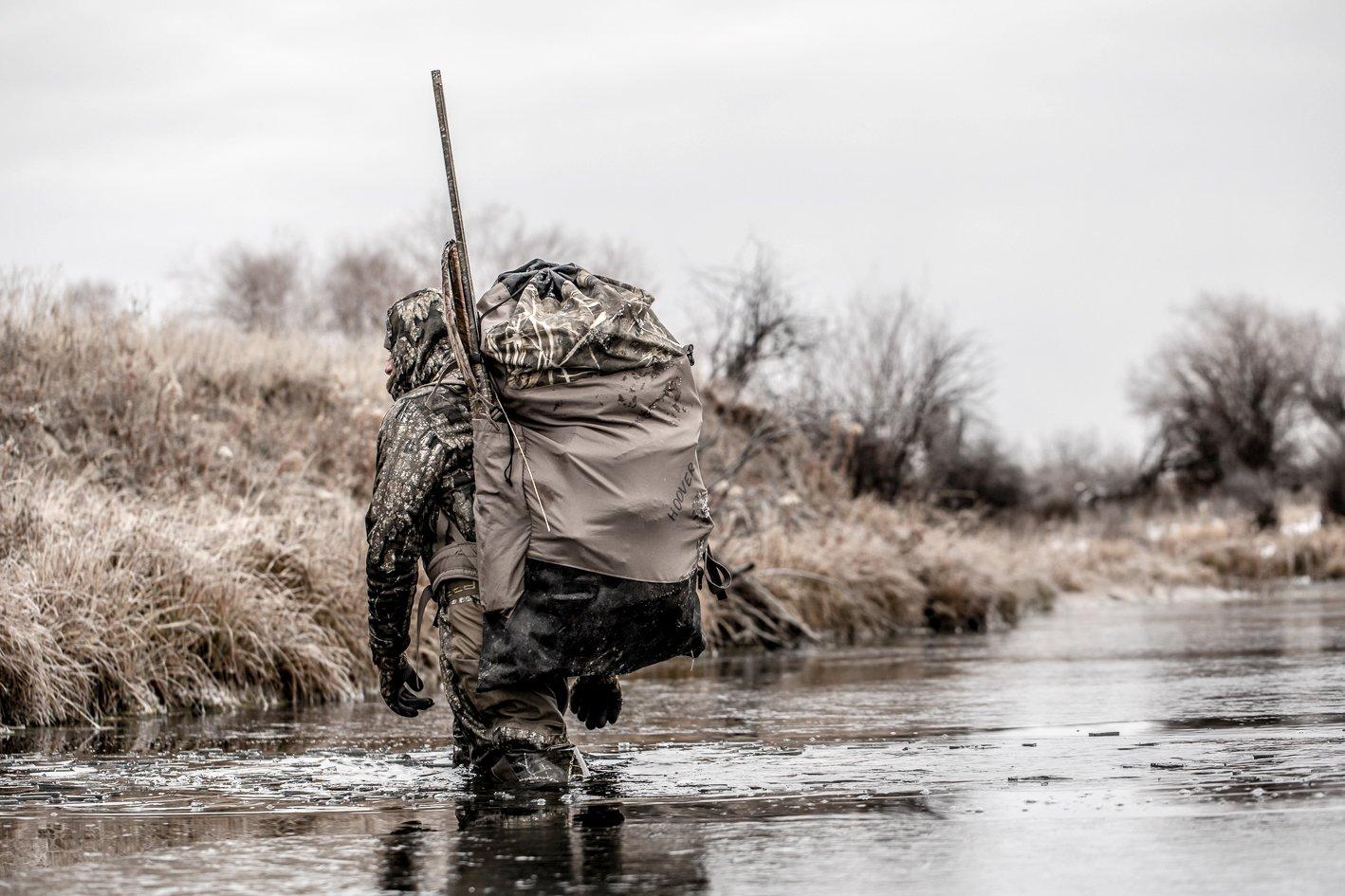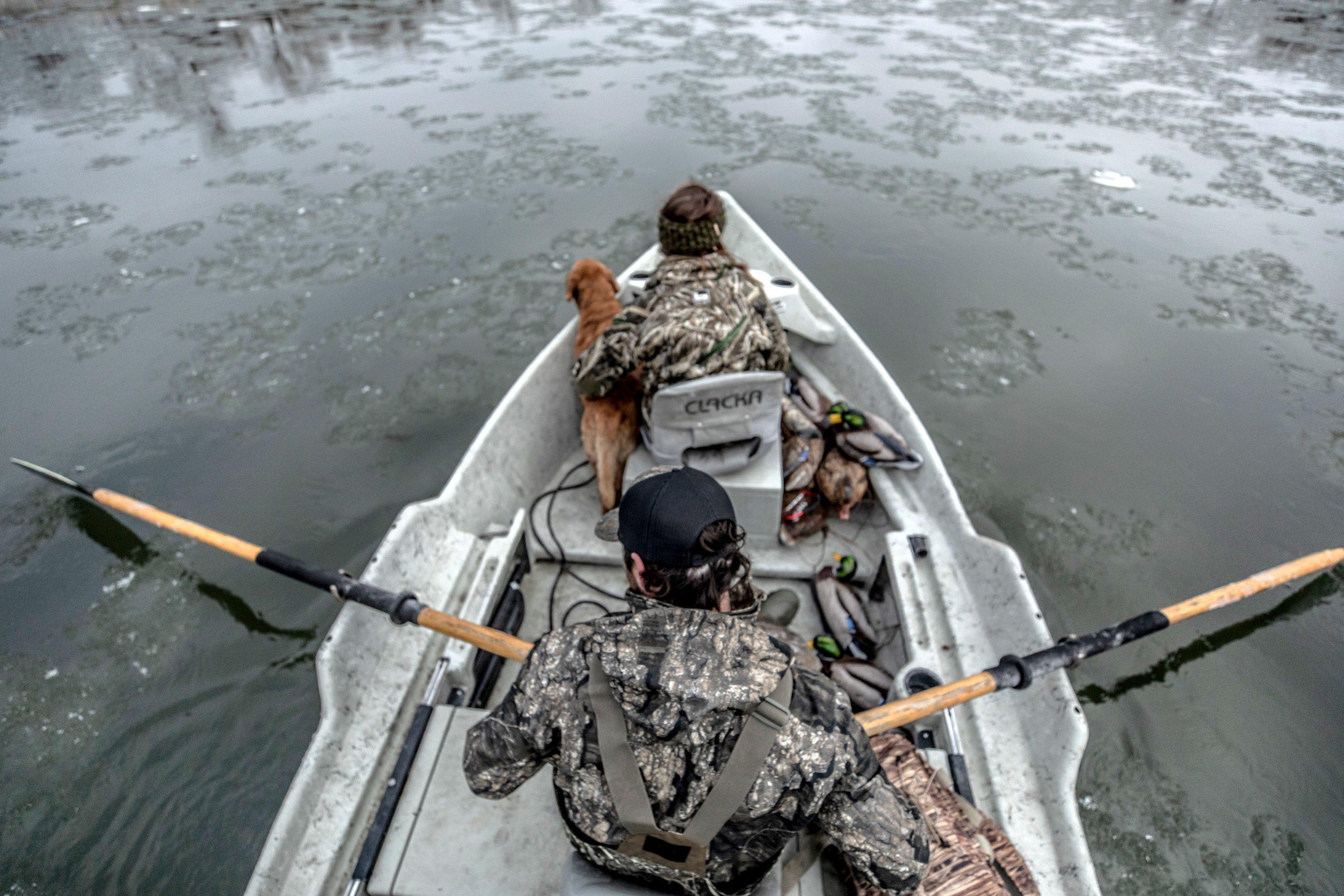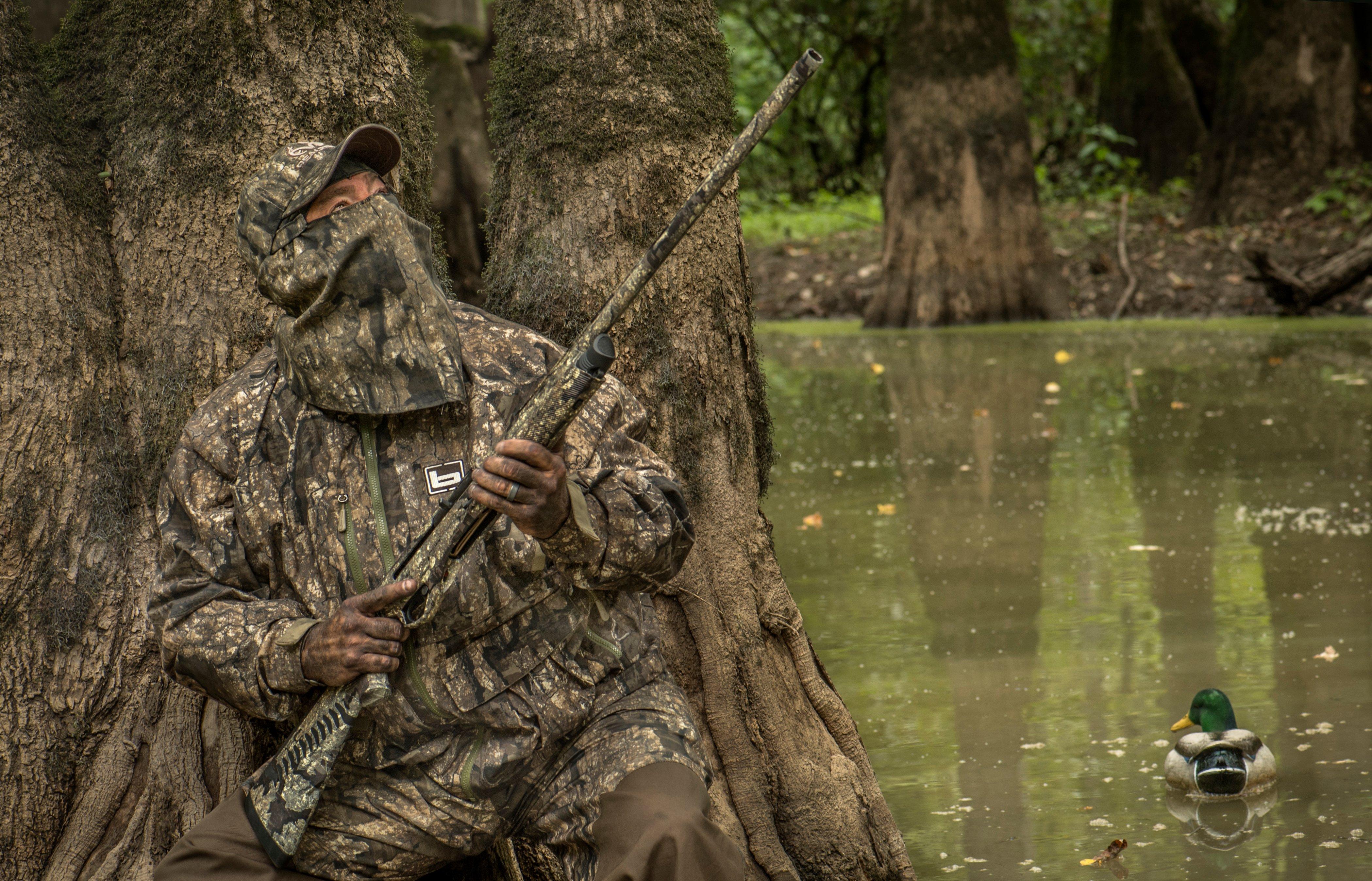The tricks your granddaddy used continue to put birds on the strap. Try these retro tactics this season

Duck hunting has really changed. Or has it? Tactics that worked decades ago still help hunters today. Photo by Nick Costas.
You have to love marketing campaigns. Through their lens, we see the modern duck hunting scene: hunters glued to cell-phone scouting apps, decked-out boats with mud motors flying through the marsh, and dizzying fleets of spinners filling every hole.
Joking aside, there’s no doubt that these and other innovations have made waterfowl hunting easier and more comfortable. In many situations, they also make hunters more successful.
But if your granddaddy hunted ducks, he probably shot a pile of them without any of that stuff. And the methods and tactics he used back then will still help you kill ducks today. In fact, many are probably superior to new approaches. Check out these 10 old-school tactics, and consider incorporating them this season. They aren’t new, but they sure do work.
Don’t Miss: 8 Great Days to Duck Hunt in 2024.
- WORK WITH NATURAL COVER
Hunters have so many great camo and concealment options nowadays that we sometimes forget the obvious: Nothing fools the eyes of ducks and geese like natural cover, whether it’s cattails, tall grass, standing corn or even shadows in a rock ledge. When birds notice nothing out of place as they approach, they’re much likelier to swing into decoys and finish.
Seek natural cover whenever possible, especially in concealment-challenged situations, such as hunting dry fields. That doesn’t mean you should set up in a fence line far from the X. Instead, look for anything that might break up the outline or silhouette of your layout or A-frame blind, such as a rock pile, a strip of grass between two fields, or even an overgrown low spot. Whether you’re hunting land or water, augment your hide with natural stuff, such as corn stalks, willow or grass bundles, or oat or wheat straw. Pay special attention to overhead cover, as birds often flare from the infamous black hole of an open blind.

Modern surface-drive motors are great, but sometimes, a quiet approach works better for ducks. Photo by Nick Costas.
- COVER YOUR MUG
This isn’t completely old-school, and in fact, face paint has become cool again. Still, many hunters neglect to hide the most glaring, sun-reflecting object in their boat: their shiny face. Maybe it’s because boat blinds, layout blinds, A-frames, and other modern hides cover us so well. But even when you’re hidden, you still have to peek out to look for birds, and your mug will glow like an orange beacon when sunlight hits it.
Wear a facemask. Paint your face. Use a hat that covers your forehead. Don’t peek or look up when birds circle. Quit standing up in the blind. Oh, and here’s a bonus old-school tip: On still mornings when wind makes little difference, set up with the sun at your back. It pays huge dividends.
- JERK A CORD
It’s easy to incorporate motion into your spread nowadays, with spinning-wing decoys, and fakes that swim, tip up or splash around. But a simple old-school jerk-cord rig works as well as anything, especially on calm days. Further, it probably looks far more natural than other options.
Jerk cords are easy to transport and set up. You can find many commercial models or rig one of your own with a long cord and a heavy weight. When ducks circle overhead, simply tug or twitch the cord to make your decoy swim. Ducks expect to see movement from their brethren on the water, and the subtle motion from a jerk cord often convinces them they’re looking at the real thing.

Other than perhaps the first half-hour of shooting light, you should cover your face to stay concealed from sharp-eyed ducks. Photo by Bill Konway.
- MIX THAT SPREAD UP
Modern full-body field decoys look almost like real birds, especially if they feature flocked heads and bodies. But they also take up lots of space in a trailer or truck bed, so hunters are often limited in how many they can set out. When you need to boost numbers, look to old-school shells, silhouettes, windsocks, and rag decoys. They’re easy to stack, store and transport, and properly placed, they still fool ducks and geese.
The key is how you use them. Place your best-looking decoys — that is, your ultra-realistic full-body models — on the downwind edge of your spread. Approaching birds see those first and for the longest time, especially if they’re fighting a strong wind to reach your spread. Use shells and other old-school fakes around and behind your hide, as they can help conceal layout blinds. Windsocks and rags can add critical motion if the breeze is sufficiently strong. Mixed with full-bodies, these traditional fakes can form a deadly combo.
- TRY V-BOARDS FOR DIVERS
While we’re discussing retro-style decoys, how about V-boards for big-water divers? They’re basically large silhouette decoys mounted on folding arms that extend out when deployed. The big silhouettes help attract birds from a distance, and low-approaching divers never see the arms until they’re within range.
V-boards work especially well to break up the sometimes-fake linear appearance of gang-rigged decoys. Place two or three in your kill hole, or use them to help cover up a layout boat from behind or to the upwind side.
You won’t find too many commercial V-boards, but it’s easy to make your own with some 2-by-4s, marine plywood and decoy paint. Plus, you can customize your boards for your target species and style of hunting. Search YouTube for instructional videos, such as the one from Jeff Coats at Pitboss Waterfowl.

Semi-autos rule nowadays, but old-school pumps and double-barrels still work well. Sometimes, they might even be a better choice. Photo by Forrest Carpenter.
- TRAVEL IN SILENCE
Nothing beats the peace and calm of the duck marsh before dawn … until the first mud motor fires up and then roars across the water, sending any ducks in the area into the next flyway.
Don’t get me wrong, mud motors are awesome tools. But in some situations, the old-school silent approach — using a skiff, canoe or other small craft — works better.
This is especially true when hunting relatively small spots where, as mentioned, birds might have spent the night nearby. Small marshes, flowages, lakes or river backwaters are prime examples. Pressured ducks already tend to leave heavily hunted spots before shooting light. Why give them a heads-up with the din of a surface-drive motor?
Of course, mud motors make perfect sense in many other situations, like when hunting big water or flooded timber, where birds typically filter in after roosting in refuges or other protected spots. But if you’ll be close to ducks you hope to shoot, slipping in quietly can pay off.
- WALK SOFTLY
Likewise, stealthy scouting on foot often makes more sense than roaring through spots in a boat. You want to find ducks that are relaxed, content and secure, not jittery and feeling pressure from noisy motorized crafts.
Sure, walking or paddling into secluded spots requires lots of work. But in many situations — green timber, or with big-water divers, for example — a low-impact approach won’t affect ducks. Use afternoons to walk near likely timber holes, and then glass and listen for ducks. On big water, find good vantage points where you can glass for diving ducks flying to and from roosting, loafing and feeding areas. Then, you can slip into a good ambush spot the next morning and hopefully hunt undisturbed birds.
Don’t Miss: Do Controlled Waterfowl Hunts Make for Better Hunting?
- TRY JUMP-SHOOTING
Since we’re on a silent-sports kick, let’s not forget the importance of basic woodsmanship when jump-shooting ducks. Admittedly, this only applies to some spots, as Southern hunters won’t want to jump-shoot birds off their rice field or timber hole. But in areas where wood ducks, mallards and other puddlers commonly loaf on small streams or rivers, jump-shooting is a great way to spend a few hours.
Obviously, silence is critical when slipping up on ducks, which is why many folks use canoes or small skiffs to float downstream. But also keep your silhouette low and behind cover and creek banks, and scan shorelines and overhead cover where ducks might hide. Be ready to shoot whenever you come to hidden bends or backwaters, as ducks will flush immediately when they see you. Turn your boat so you’re in good position for a shot, and keep your gun at port arms. Done correctly, jumping stream ducks is almost as fun as fooling birds over decoys.

Bonus tip: Whenever possible, set up with the rising or setting sun at your back. It makes a huge difference. Photo by Austin Ross.
- PASS-SHOOTING WORKS, TOO
This subject can be taboo because it invokes images of sky-busting goons on refuge boundaries. And obviously, truly convincing ducks and geese with smart spreads and realistic calling remains the epitome of waterfowling. However, ethical, common-sense pass-shooting is a legitimate tactic when you can’t use other methods.
I’ve used it on prairie hunts when birds fly from one water to another but, for whatever reason, you can’t hunt their destination. In the right situation, positioning yourself near a fence, hay bale or other cover, and waiting as birds top a rise and fly over can produce good action. Just make sure you aren’t cutting off other hunters who might be working those ducks, and as always, don’t take stupid long-distance pokes.
- USE A VINTAGE GUN
I own a pile of semi-auto shotguns, and they function phenomenally well. And I’m not alone, as most folks tote auto-loaders into the marsh or woods nowadays. But sometimes, old-school pumps or double-barrels might be the ticket.
That’s especially true when hunting during conditions that might prevent autos from cycling reliably, such as severely cold temperatures, snow or ice storms, or when hunting saltwater. Or in some cases, a pump or double-barrel might simply fit you better. And now and then, it’s nice to get nostalgic and tote a favorite old gun to the blind. Either way, don’t ignore those old-school shotgun actions.
GO RETRO
As with any tactic, these old-school approaches won’t guarantee full limits. They will, however, boost your success in the long run. And after days when they really pay off, you can call your granddaddy and thank him for the tips.












